The OnePlus 3 Review
by Brandon Chester on June 20, 2016 8:00 AM EST- Posted in
- Smartphones
- OnePlus
- OnePlus 3
GPU Performance
GPU performance is one of the areas where Snapdragon 810 actually tended to do quite well. It's also the case that GPUs generally see larger performance gains year over year than CPUs. We already saw how Adreno 530 performs in the LG G5 review, but the device being compared to was the LG G4, which used Snapdragon 808. The OnePlus 3 represents an opportunity to compare a Snapdragon 810 device to its successor using Snapdragon 820.
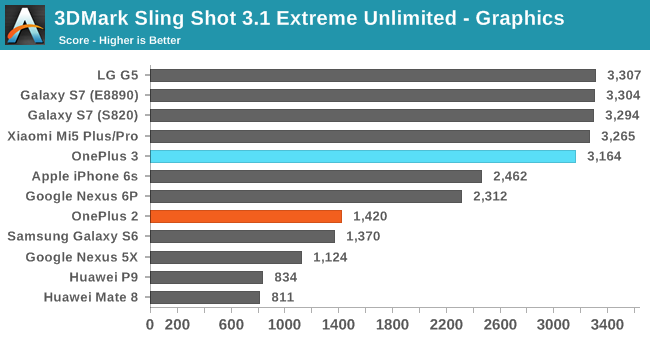
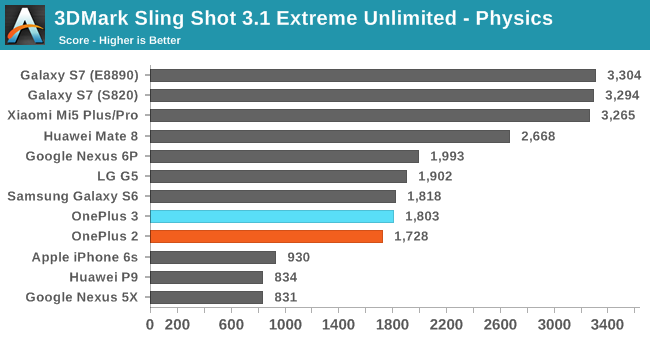
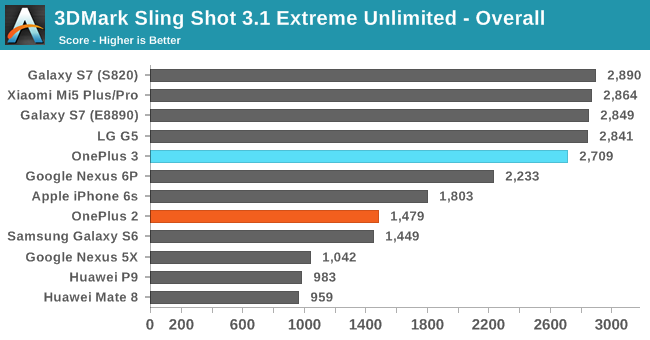
The OnePlus 3 does very well in 3DMark Sling Shot. In both the physics and graphics tests it trails the LG G5 slightly, but the gap isn't anything truly significant. Exynos 8890 is still not something I can compare to until our Galaxy S7 review is posted, but barring that it's clear that Snapdragon 820's Adreno 530 gives the fastest smartphone performance in this test, and when looking at the graphics performance the performance is over two times faster than the OnePlus 2.
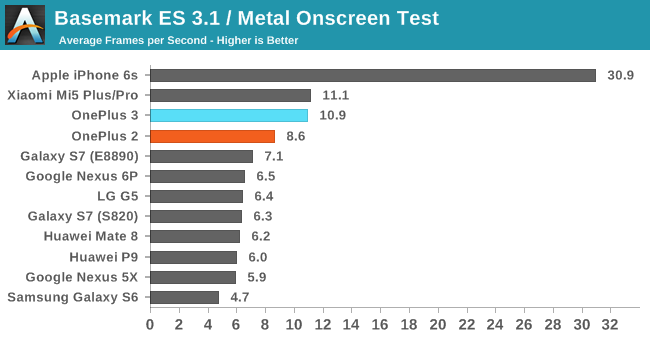
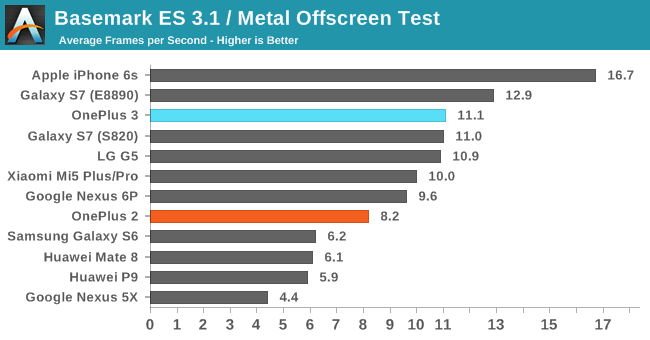
In BaseMark ES 3.1's on screen test the OnePlus 3 manages a significant lead over the LG G5 as a result of its lower resolution. In the off screen 1080p test both phones have essentially the same performance, which is what you'd expect. It looks like Adreno 530 doesn't make the same gains in this test that it does in some others, and it's not clear whether this is just the result of driver optimizations or something about the benchmark that is able to perform batter on other GPU architectures, which could be contributing to the iPhone's lead even in the off screen test.

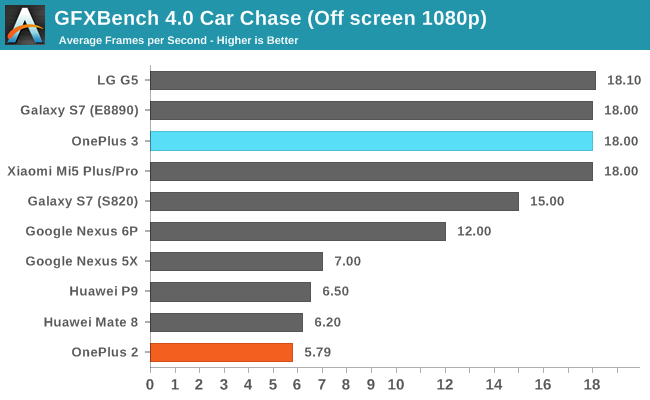
In GFXBench Car Chase the performance of the OnePlus 3 is in line with the LG G5. On screen performance is significantly higher due to the lower resolution display, while off screen performance at 1080p is about the same as the G5 and exactly the same as the on screen result. As far as absolute GPU performance goes, both of our Snapdragon 820 devices are at the top of the chart for absolute performance, and that's good news for anyone playing games or using software that benefits from a powerful mobile GPU.
NAND Performance
The OnePlus 3 moves to a UFS 2.0 NAND solution, which OnePlus claims is three times faster than the eMMC storage used in the OnePlus 2. In more realistic testing you probably won't end up achieving speeds three times faster than the OnePlus 2 since it actually wasn't slow at all by eMMC standards, but there should be a decent uplift in NAND performance nonetheless.
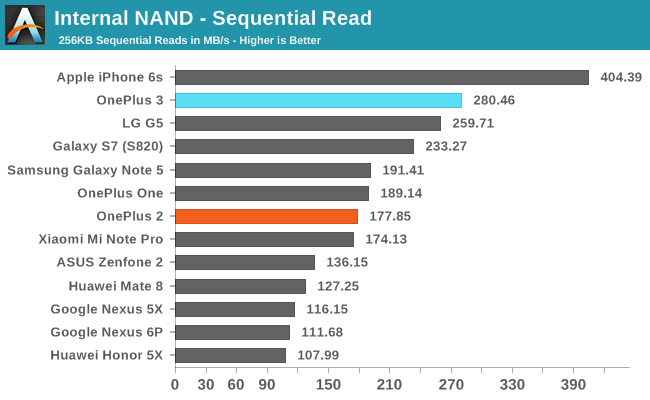
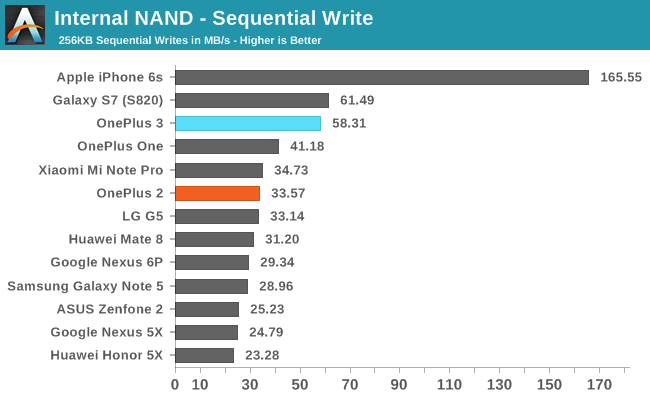
The move to UFS 2.0 brings healthy gains over the OnePlus 2's storage performance, although as I said, the OnePlus 2 didn't perform poorly at all by the standards of eMMC devices. Sequential read and write performance is actually the best that I've measured so far on an Android device. We're still not looking at anything close to what you get for sequential performance on iOS devices, but there are some other factors at play like the fact that the iPhone was a 128GB unit while our Android devices are usually 32GB or 64GB devices. In any case, the OnePlus 3 doesn't present any problems with storage performance, and you certainly won't run into the same issues that you can with budget smartphones at the $200-300 range where the eMMC solutions can be exceptionally slow.










176 Comments
View All Comments
UtilityMax - Wednesday, June 22, 2016 - link
Sadly, in the world of Android the competition has forced the companies to start hyping the features nobody asked for, such as QHD screens, octa-core processors, and now I guess RAM (6GB of it, no less). At the same time, the Android vendors often fail to deliver features people really wanted, such as better battery life, quality screens (as in good brightness and black levels, at least), sd card slots, unlocked wireless bands, and single-core performance that could match at least the three year old Snapdragon 800/801 at an affordable price.fanofanand - Monday, June 20, 2016 - link
I seem to recall them highly lauding the Moto-G, and even the Moto-E. Your complaints are largely invalid, as they do take price into account. They are technical reviewers, if they started every sentence with a caveat about price it would be unbearable reading. "Xiaomi showed us with the Redmi note 3 pro that a 4000 battery is possible with a $200 or less phone".Then go buy the Xiaomi. If you think that phone is the bee's knees then vote with your wallet. If a massive battery is the sole important factor in your phone purchasing then your search is over! For the rest of us, it's nice to see the technical analysis and decide for ourselves what amount of compromise is worth the cost savings.
FWIW I am on my 2nd Nexus 5 because no company has made anything since that is a better value. I get the value proposition, I do.
thek - Monday, June 20, 2016 - link
You obviously didn't understand the argument, sir.The point was that if even a low end cheap Chinese phone can have better batteries, than huge companies can include them too. But they don't. So why is that?
fanofanand - Monday, June 20, 2016 - link
Maybe because there are no employee protections in China? Maybe because there are no real consumer protections in China? The cost of doing business as a Chinese company is a fraction of the cost of doing business in the EU or the US. There is a reason most Chinese products don't get sold in either of those two markets, and it isn't just patent/copyright laws. You might as well ask yourself why you can buy 10 Chinese t-shirts for the same price of one US made t-shirt. BOM is not static between nations.thek - Monday, June 20, 2016 - link
You do realize that the IPhone is made in China right?..You missed it again: the correct answer was that those companies are being cheap on us consumers, even on their premium priced flagships because they want to keep making billions of dollars of revenue per quarter (not even talking yearly!!).
they can provide 64GB as base storage and 4000+ batteries as minimum. They just don't want to.
melgross - Monday, June 20, 2016 - link
Ah, you're missing the point. Quality manufacturers all pay about the same thing for the same things. A screen may be made by one manufacturer, but their customers may spec a lower, or higher quality for brightness, speed, color quality, contrast, power draw, and other matters.The same thing is true for everything else. There are higher quality batteries, and lower quality batteries. The better ones may last for 1,000 recharges, and the cheaper ones may just last 500. Storage is, again, the same. Apple obviously uses higher quality NAND, hence the much higher speeds. It's been said elsewhere too. When making cheaper phones, compromises must be made. Not spending the money to calibrate a screen is a factor that we see here. Even if they come out with an sRGB update, without calibrating each screen, it will still look pretty bad. Cheaper components and fewer features are the way to go. How a manufacturer balances that all out is the differentiating factor.
kurahk7 - Monday, June 20, 2016 - link
Here are a few reasons why the display is the single most important part of a smartphone-1. You stare at it all day long.
2. The image that you see while taking a photo is expected to be the same as when you print it out or share to a friend.
3. You will be able to enjoy content the original creator intended.
echoe - Monday, June 20, 2016 - link
I mean, if a phone didn't have a working display it would not be usable. The screen needs to be good. They mention the caveats to this judgment in the review, but obviously it's pretty bad ...UtilityMax - Wednesday, June 22, 2016 - link
Why do you think that 400USD is not enough money for the vendor to deliver a quality screen? In fact, the vendors have gotten quite lazy recently. The 600+ USD prices were artificially inflated to herd the consumers into signing the multi-year cellular plans so they got big discounts on hardware. Now that the heavy discounting of the locked carrier-branded smartphones by the carriers is nearly gone, I don't know what's going to keep justifying the 500-600USD prices on the flagship phones when a phone like Nexus 5X offers 90% of functionality, at 40 percent discount. The Nexus 5X normally sold for well under 400USD. It had a great display and great camera, and was basically a good all-around phone. Yes, the SoC was slower than that in OP3, but that issue affected most phones of the 5X generation.The_Assimilator - Monday, June 20, 2016 - link
Hey look it's... not a GTX 1080 review.